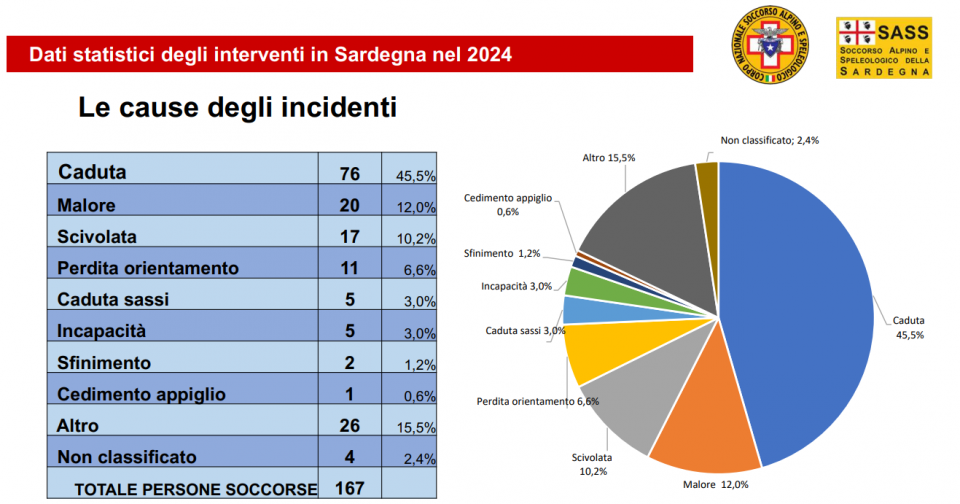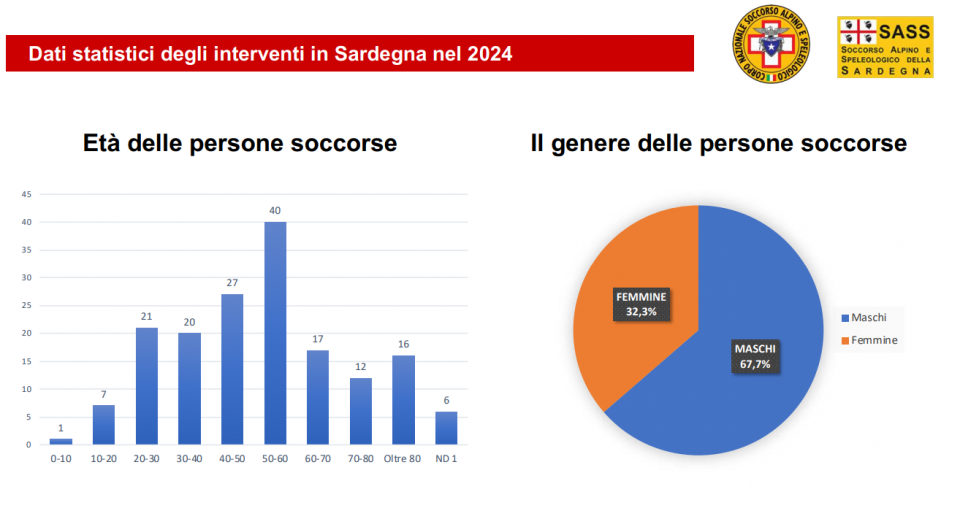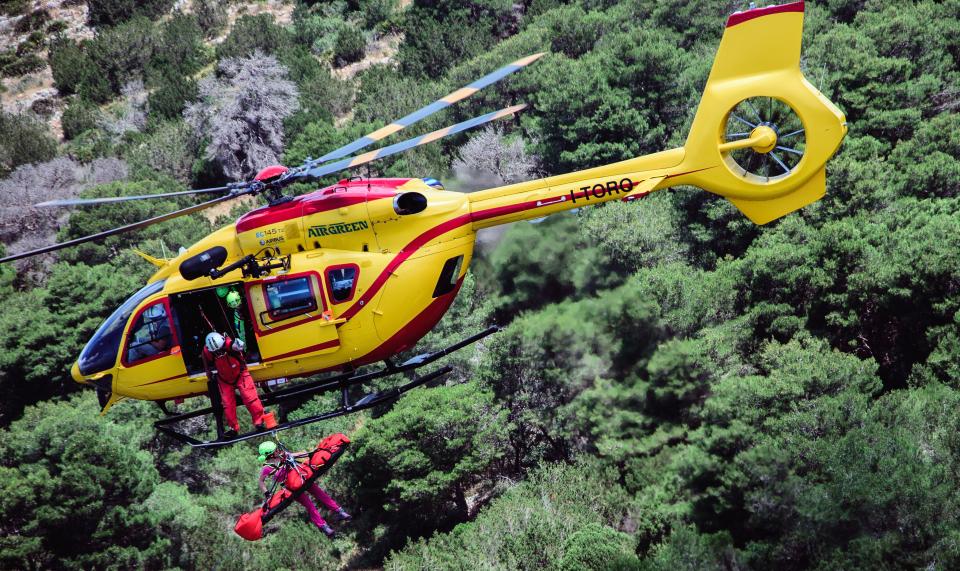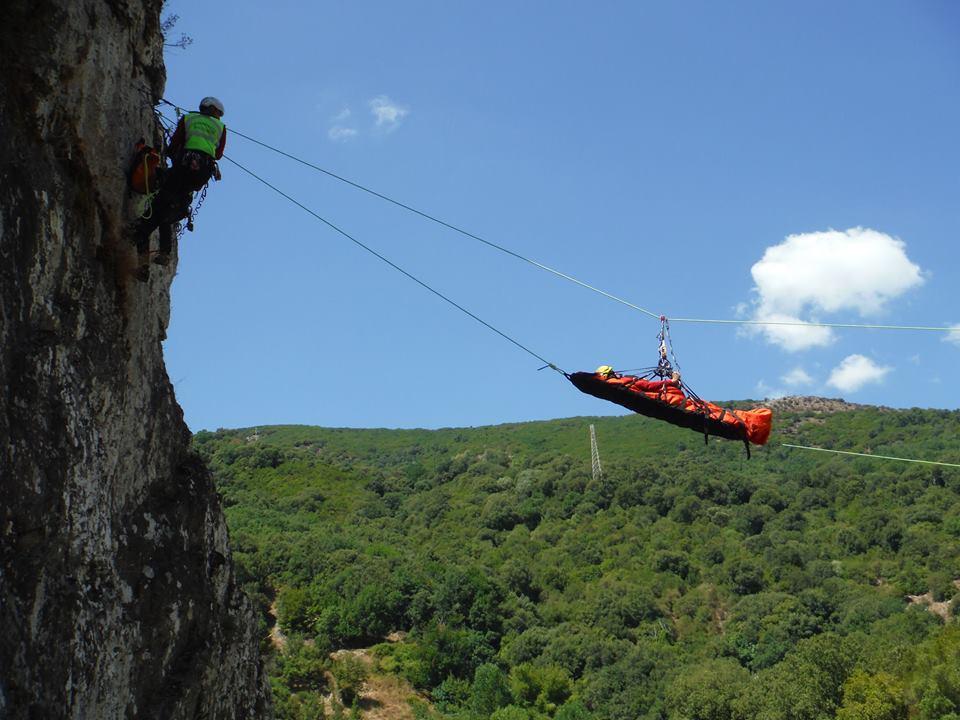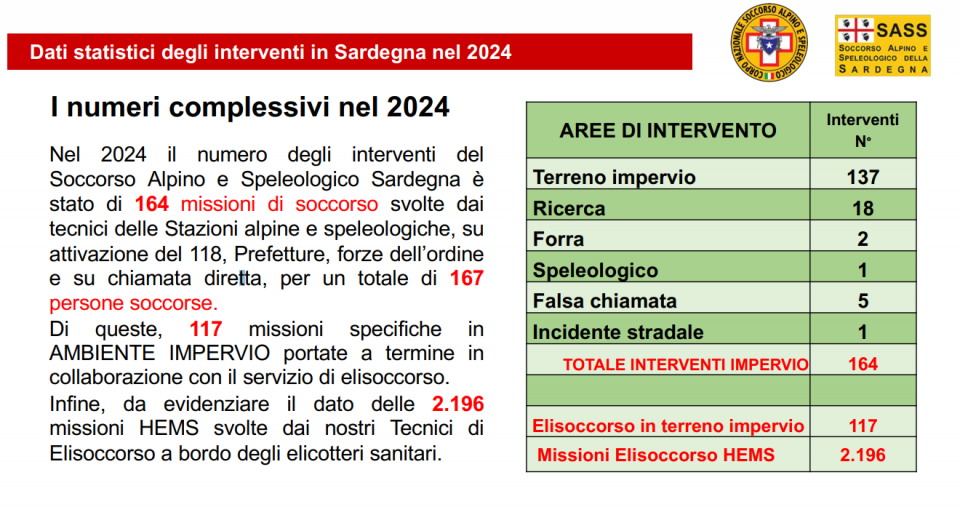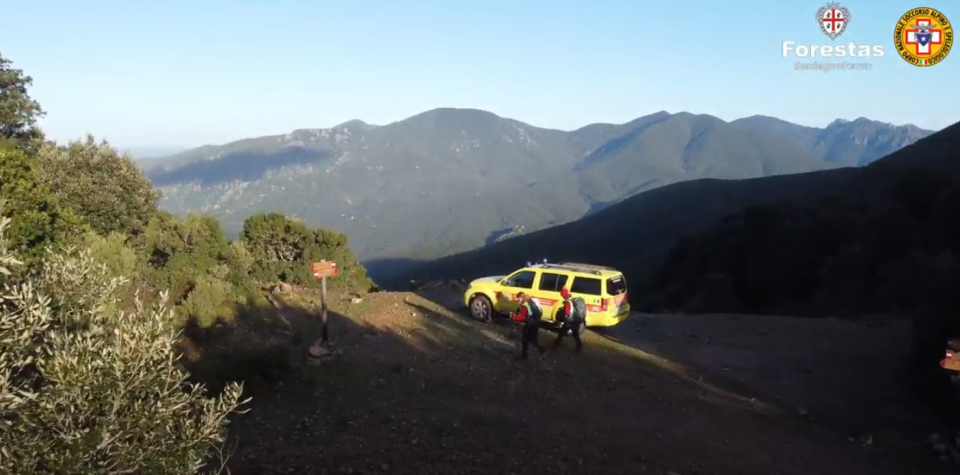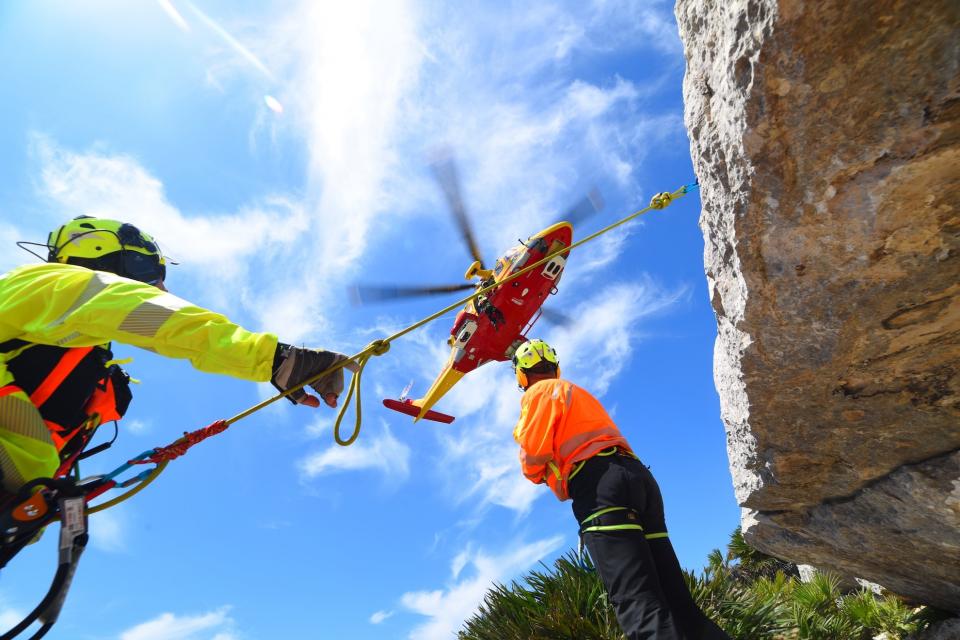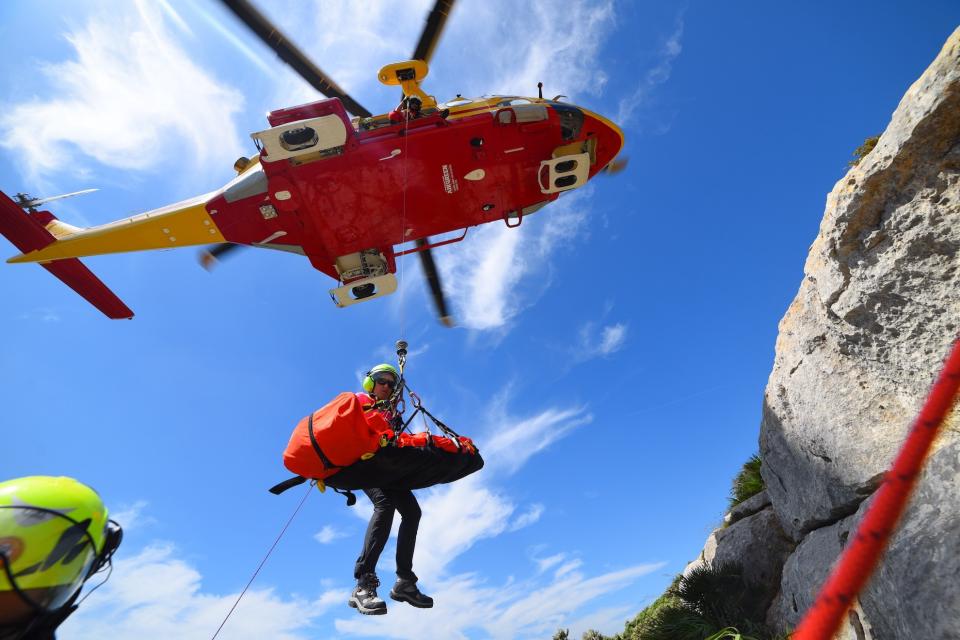"Safety on the trails: what do the Italian data from 2024 say? Meanwhile, Forestas and Alpine Rescue are collaborating for trail inspections."

[Report by the Trails Sector of the Forestas General Direction - reading time: 9 minutes]
Outdoor Safety: What Does the 2024 Data Say?
In the Italian and regional context, the public safety system related to Search&Rescue (SAR interventions for search and rescue, in case of accidents or missing persons in difficult environments) is managed by a collaborative and efficient system involving, among others, the Fire Brigade and the Guardia di Finanza (each of which has its own operational unit that includes helicopter rescue skills) together with the National Alpine and Speleological Rescue Corps (CNSAS) and a universe of volunteer associations.
A definitely "key" role is that of the CNSAS, which for over 70 years has carried out technical-sanitary and non-sanitary rescues in mountain, cave and difficult environments throughout the national territory with more than 7,000 highly specialized operators.
The 2024 Report
The CNSAS is currently presenting its report on activities carried out in 2024: in collaboration with the National Health Service and the 118 system, they guarantee rescue and immediate assistance to injured subjects, people in difficulty or in imminent danger of life, the search and recovery of missing persons and the fallen. Some data on the year just ended: 12,063 rescue missions, providing assistance to 11,789 people.
In general, the numbers remain high and worrying, in line with the last two years. The man-hours used were 183,846, for a total of 314,228 man-days, with 42,589 volunteer technicians involved.
And Sardinia, with its enormous share of outdoor activities, plays an important role in this context: not only for the exponential growth of hiking (including on the new 3000 km of RES managed by Forestas in recent years, in addition to the almost 1000 km of Sardinia's Paths) but also for the very high attendance of difficult environments such as gorges, ledges, climbing routes, via ferratas, and canyoning.
A context that on the one hand has extremely positive aspects for the outdoor tourism sector in our island but, at the same time, poses and is posing serious and complex problems regarding the anthropic load, the offer of professional skills suitable for guided use in the various contexts, hospitality (a network of shelters and bivouacs not yet operational in Sardinia) and, of course, the case history of accidents in difficult environments with high rescue criticalities.
Causes of interventions, at the national level
The main causes of interventions remain substantially unchanged compared to previous years, in fact, the following stand out:
- Fall or slip: 43.2%
- Incapacity during the activity carried out: 26.5% [on this aspect, prevention and information are fundamental, as well as the care and verification of the professional skills that offer "guidance" and accompaniment]
- Illness: 12.7%
Followed by: other causes (9.6%), bad weather (4.1%), landslides (1.3%), avalanche events (0.7%) and anaphylactic shock (0.4%).
The most involved activities
Hiking is confirmed as the main cause of accidents (44.3% of cases), followed by:
- Alpine and Nordic skiing: 14%
- Mountain biking: 6.8%
- Mountaineering: 5.9%
- Mushroom picking: 3.4%
- Work activities: 2.6%
- Via ferratas and climbing activities: 3.6% overall
Also noteworthy is the presence of interventions attributable to hunting activities, air sports and caving.
The physical condition of the rescued people
In 2024, at the national level, there were:
- 466 people deceased and 1,431 seriously injured
- 5,288 slightly injured and 299 injured with impairment of vital functions
- 4,187 unharmed and 118 missing
The profile of the rescued person
The prevailing profile remains: Italian man between 50 and 60 years old, slightly injured after a fall while hiking in August - the time of year that is confirmed as the one with the highest number of interventions (18%).
More generally, these are the statistics:
- Nationality: 80.4% Italians, followed by citizens of Germany (6.8%), France (1.6%) and Austria (1%).
- Prevailing age: between 50 and 60 years (16.36%), followed by over 60s and young people between 20 and 30 years.
- Gender: 67.9% males, 32.1% females.
- Membership in the Italian Alpine Club: 91.4% non-members, 8.6% members.
When and where rescues intervene
Almost half of the interventions are concentrated in the summer months: July (14.4%), August (18%) and September (8.6%), in line with the frequencies of the main outdoor activities practiced during the warm season.
Territorial distribution of interventions
The most involved territories are:
- Piedmont: 15.9%
- Valle d'Aosta: 14.3%
- Trentino: 11.7%
- South Tyrol: 10.9%
- Lombardy: 10.4%
- Veneto: 9.2%
All other Italian regions follow, with data consistent with previous years.
IN SARDINIA: 164 rescue missions were carried out by the technicians of the Alpine and Speleological Stations (activated by 118, or by the Prefectures, by the Police Forces or by direct call to the CNSASS) for a total of 167 people rescued, with 117 specific missions in difficult environments completed in collaboration with the helicopter rescue service. Also noteworthy is the data of 2,196 HEMS missions (carried out by helicopter rescue technicians on board health helicopters).
The comparison with previous years: stable numbers, but still too many deaths
In the three-year period 2022–2024, a stable and constantly high trend is recorded - at the national level - of the total number of rescue missions carried out by the CNSAS. After the peak of 2023, with 12,349 missions, 2024 stands at 12,063 missions, a figure in line with the previous year and a sharp increase compared to 2022 (10,367 missions).
Data that are closely related to the well-known explosion of the outdoor sector after the slingshot effect of the Covid-19 pandemic period.
The number of rescued people also remains high:
- 11,789 in 2024
- 12,365 in 2023
- 10,125 in 2022.
On the front of people who died in difficult environments, there is a slight decrease compared to previous years, although the data remains highly significant:
- 466 deaths in 2024
- 491 in 2023
- 504 in 2022
The analysis confirms a constant pressure on the mountain rescue system, with numbers that highlight the need for constant prevention, awareness and training activities to reduce risks and limit accidents.
National CNSAS REPORT
At this link it is possible to learn more about the activities of the National Alpine and Speleological Rescue Corps and read the full report.
Focus on Sardinia
905 man-days were used in Sardinia by the CNSAS, equal to 8719 hours in a year. Overall, 2024 recorded 164 rescue missions in Sardinia for a total of 167 people rescued, of which 117 on missions in difficult environments, often operated by helicopter transport. Accidental falls (45.5%), illnesses (12%), slips (10.2%) and loss of orientation (6.6%) are the main causes of accidents in Sardinia.
Interventions in difficult environments and more "critical" activities
Also in this case important numbers: 137 interventions on difficult terrain | 18 for missing person searches, of which 2 in gorges | only 1 in the speleological field.
The activities carried out by the injured who activated the rescues see in Sardinia a clear predominance of hiking (47.3%) followed by climbing/mountaineering (6%) hunting with 9.6% of cases (interference hunting activity/hiking on which Forestas has also focused much among the main critical issues reported in the trail offices and to the attention of the Regional Technical Table for the RES). And finally, among the most practiced and least "risky" activities, mountain biking (just 2.4%). It should be noted that the 6% of accidents attributable to mountaineering activities (therefore with ultra-hiking difficulty levels and with specific equipment, from EEA upwards) or climbing on rock walls are a huge wake-up call, in relation to the number of practitioners (actually small compared to hiking tout-court exploded in Sardinia in the post-Covid19 period also thanks to the development of the RES and the Paths with GAE guides).
Age and origin of rescued people, and most critical months in Sardinia
The age of the people rescued in Sardinia - according to the data provided by the CNSASS - is significant: the median and the highest percentage of interventions (40% of the total) concern the "50-60 years" range with a clear prevalence of men (67.7%). Remarkable, but not surprising, is the high percentage of over eighty-year-olds rescued (16%).
Mostly Italian (about 90%) is the nationality of those who need rescue, followed by Germans (almost 5%). And needless to say, the most critical months are the summer ones; in reality, however, the highest frequency range starts from May.
The areas most affected by alarms in difficult areas are Ogliastra and (perhaps a little unexpectedly) the Sassari area.
HERE the full report of the CNSASS for Sardinia.
The Five-Year Collaboration signed by Forestas with the Alpine Rescue for trail safety
The collaboration between the Alpine and Speleological Rescue of Sardinia (S.A.S.S.) and the regional agency Forestas - which by regional law manages the entire trail network on the island, adds to the collaboration with the Italian Alpine Club and will allow us to work, in the years to come, to increase the number, quality and above all the safety of official trails and long-distance routes (such as the Sentiero Italia) and the other regional routes provided for in the three-year development plan.
Among the key activities provided for by the collaboration established with the SASS, the following are included:
- support to the exercises of volunteers, also with the use of the forestry and agency personnel, to strengthen the operational capacity and mutual "know-how"
- full access to all regional forest tracks, including those barred, essential ascent route in case of rescue
- the sharing of information and the development of a quality hiking network
- the planning and design of safe trails throughout the island
- the SASS also has access to all the information of the new Regional Trail Cadastre and will share its own with the Agency
- the SASS will help Forestas to assess critical issues and mitigate risks along trails, MTBike tracks and bridleways.
WORKING FOR THE SAFETY OF HIKING TRAILS
There is still much to do on this front: the representatives of the Forestas Agency illustrated the management aspects related to the Hiking Network of Sardinia (RES) and the collaboration protocol signed with the S.A.S.S. also in the last session of the Regional Technical Table for the RES.
In Sardinia, therefore, we continue in the wake of the collaboration started in 2019 to concretely enhance the development of the Trail Network, now integrated with the Sardinia's Paths network.
In addition to a joint regional working group Forestas-SaSS, the following are planned: sharing of logistical resources, exchange of information and training for trail safety, updating on technologies, use of forest structures for exercises (including joint ones), intervention and inspection plan for monitoring and for safety and revision of trail classifications (independent and "third party" controls by the Alpine Rescue).
What is the National Alpine Rescue Corps, in Italy and in Sardinia
They are super specialized and equipped volunteers, integrated with the regional Civil Protection system. They operate according to national standards in mountains, caves and cavities, gorges and canyons, submerged caves, for the search for missing or injured people also with the support of canine units, also helicopter transported.
The S.A.S.S. is the territorial articulation for Sardinia of the National Alpine and Speleological Rescue Corps (CNSAS) whose purposes, sanctioned by art. 2 of the national Statute, are:
- rescue of the injured, those in danger and recovery of the fallen in the mountain territory, in the underground environment and in the difficult areas of the national territory;
- prevention and supervision of accidents in the exercise of mountaineering, ski mountaineering, hiking and mountain sports activities, speleological activities and any other activity related to tourist, sports, recreational and cultural attendance in mountain and underground environments;
- contribute to rescue in the event of calamitous events in cooperation with the Civil Protection structures, within their technical and institutional competences;
- training, education and updating of their members.
The CNSAS is also entrusted with the coordination function, in the case of intervention by several rescue organizations, in the alpine environment or in difficult or hostile environments and its structures are recognized by the State as "exclusive reference subjects for the implementation of rescue in the mountain territory and in the underground environment". Law 18 February 1992 n.162 provides in art 4 c.3 that "The volunteers of the Corps engaged in rescue operations and exercises can circulate with the necessary vehicles and canine units, in derogation from the prohibitions and limitations imposed by regional and provincial laws and local regulations, even in areas included in national parks, regional parks, natural reserves and protected areas".
The SASS, as a territorial service of the C.N.S.A.S. is a public utility service as indicated in Law 21 March 2001 n. 74 and is a national operational structure of the national Civil Protection service for Law 24 February 1992 n. 225. The headquarters are fixed at the legal headquarters of the Italian Alpine Club in Milan.
The CNSAS operates throughout the national territory through 21 Regional Services, each constituted for each region or autonomous province of the Italian State. The Regional Services are, in turn, structured in Delegations, organized extensively in operational units called Stations, with the task of providing rescue. In Sardinia it is operative with two delegations: the XXIX Alpine Delegations and the VIII Speleological Delegation, which include about 220 rescuers.
The XXIX Alpine Delegations operates throughout the regional territory and is divided into 6 stations: Cagliari, Sassari, Nuoro, Ogliastra and Medio Campidano, plus the newly formed station of Olbia. The VIII Speleological Delegation operates throughout the regional territory and is divided into 4 stations: Cagliari, Sassari, Nuoro and Iglesias.
Links
- Delibera Amministratore Unico n. 41 del 2024
- Firmato il protocollo di intesa tra Forestas e Soccorso Alpino per la sicurezza…
- Forestas e Soccorso Alpino insieme per le verifiche sui tracciati e sulla segna…
- Firmato il protocollo di intesa tra Forestas e Soccorso Alpino per la sicurezza…
- Delibera n.44 del 30.05.2018
- Rete Escursionistica (RES): informazioni per i Comuni e per gli Enti
- Legge 18 febbraio 1992 n.162
- Il sito web del SOCCORSO ALPINO della Sardegna

